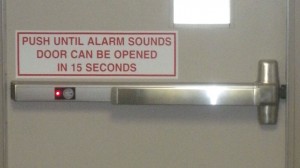 Our sales team just got back from the National Retail Federation— Loss Prevention trade show, and the hot topic was delayed egress.
Our sales team just got back from the National Retail Federation— Loss Prevention trade show, and the hot topic was delayed egress.
One after another, people came by the booth to get more information. Questions ranged from how delayed egress works, to when it is allowed, to the issues with its implementation.
Given the recent peak of interest in delayed egress and all of the questions about it, I wanted to answer some of these questions in this article.
Delayed Egress: The Low Down
Delayed egress is a locking feature that allows you to delay the opening of the door. When someone engages the lock, an alarm will sound continuously while he/she waits for a specified period of time (typically 15 seconds) before it unlocks.
This is particularly useful if you have issues with merchandise disappearing from your facilities. A member of loss prevention is often able to get to the door before the thief exits the facility with the product.
The Options
There are two types of delayed egress hardware:
- Mag locks; and
- Exit devices.
Mag Locks
Mag locks are electromagnetic locks that are operational only when power is applied. As a result, depending on whether or not your lock is fail-safe or fail-secure, when power is lost, the lock will either be stuck in an unlocked state, or stuck in a locked state.
Because of this, there are a host of regulations around them. In fact, the Denver Building Code has an entire page dedicated to them (see page 105). Couple that with the restrictions around delayed egress (see page 106), and you are actually quite limited in when you can use delayed egress with mag locks.
Should you opt for mag locks with delayed egress, we recommend the Sargent 57-8810F or the Detex V40xEM. These are both heavy-duty products.
Exit Devices
The other (and more popular) option is an exit device with delayed egress.
Exit devices are not burdened by all of the rules and restrictions that accompany mag locks, so you only have to concern yourself with the delayed egress codes.
There are a number of delayed egress exit devices available; however, our go-to product is the Detex V40xEE. This is because Detex is one of the top specialists in panic hardware, and they tend to have highly competitive pricing.
The Nitty Gritty: Rules and Regulations
 Unfortunately, I cannot list all of the delayed egress rules and regulations in this article, because they vary based upon the jurisdiction in which your facility is located. In other words, if you have facilities across multiple counties, you could be looking at different rules for each of your buildings.
Unfortunately, I cannot list all of the delayed egress rules and regulations in this article, because they vary based upon the jurisdiction in which your facility is located. In other words, if you have facilities across multiple counties, you could be looking at different rules for each of your buildings.
However, there are a few overarching regulations that you must follow.
- You must have a fire system, and the delayed egress hardware has to be tied into it.
When the fire system is activated, the locking devices must allow immediate free egress.
- There must be a sign posted on the door that reads, “Push Until Alarm Sounds. Door May Be Opened in 15 [30] Seconds.”
This sign must be located above and within 12 inches of the device.
By and large, you cannot install delayed egress if your building is classified as A (occupancy of 1000 or more people), E (educational), or H (healthcare).
Implementation: Approval, Selection, Coordination
The first thing you need to do before installing delayed egress hardware is to get approval from your local Authority Having Jurisdiction (AHJ).
Do you have facilities in multiple counties? If so, remember when I mentioned that different jurisdictions have different rules? Sorry to be the bearer of bad news, but you will need to get approval from each AHJ.
Once you have approval, you need to select the appropriate hardware and coordinate the install.
Installation of delayed egress hardware requires lots of coordination, because you will be working with at least four different individuals:
- Your AHJ;
- Locksmith;
- Electrician; and
- Fire alarm company.
Your AHJ will provide approval, the locksmith will install the actual device, the electrician will wire it, and the fire alarm company will tie it into the alarm system.
As you can tell, navigating the complex world of delayed egress can be a confusing and frustrating process.
If you need help determining if delayed egress makes sense for you, and if so, how to go about selecting a product, getting it approved, and installing it, let us know. We are always happy to help!
